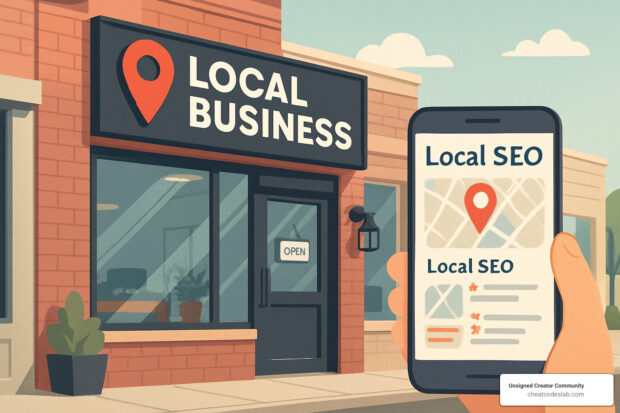
Why Ranking on Google Matters
Google ranking tips are crucial if you want your website to stand out. Without them, your search results might get buried.
Here’s a quick list to get you started on what Ill be going over today:
- Use relevant keywords.
- Create high-quality content.
- Earn backlinks from reputable sites.
- Ensure your site is mobile-friendly.
- Improve your page load speed.
SEO, or Search Engine Optimization, is essential for making your site visible to Google. Think of it as setting your storefront on a busy street rather than a quiet alley. Google’s algorithm goes through phases like crawling, indexing, and serving to determine where your page lands in search results. Without SEO, your online presence can be non-existent. My go to Cheat Code App for ranking my websites on GOOGLE is Adaptify.ai Make sure to check it out after reading this blog.
—
My name is digitaljeff. With over 20 years of experience in tech, media, and marketing, I know a thing or two about Google ranking tips. From pioneering live-streaming techniques to scaling content strategies, I’ve helped countless brands climb the Google ladder.

How to Rank Higher on Google
Conduct Keyword Research
The first step to improving your Google ranking is keyword research. Keywords are the terms your audience types into search engines. Identifying the right keywords helps you create content that matches user intent.
Start with broad terms related to your industry, then drill down to more specific, niche keywords. For example, if you run a pet store, start with “pet food” and narrow it down to “organic dog food” or “grain-free cat treats.”
Use tools like Google Keyword Planner to find keywords with good search volume and low competition. This will help you target terms that are easier to rank for. Understanding user intent is crucial. Are people looking for information, or are they ready to make a purchase? Tailor your content accordingly.
Build a Solid Site Structure
A clear and logical site structure is vital for both users and search engines. Think of your site as a hierarchy, with your homepage at the top, followed by category pages, and then individual content pages.
- Site Hierarchy: Make sure your site has a clear hierarchy. This helps search engines understand the importance of each page.
- Navigation: Ensure your site is easy to steer. Users should be able to find what they’re looking for in just a few clicks.
- Internal Linking: Use internal links to connect related content. This not only helps users but also makes it easier for search engines to index your pages.
Create Valuable Content
Google ranks pages that provide value to users. Your content should be high-quality, informative, and engaging.
- High-Quality Content: Aim for long-form content, around 2,000 words. HubSpot found that longer content tends to rank better and attract more backlinks.
- Multimedia Approach: Use videos, infographics, and images to make your content more engaging. Different types of content can attract different audiences.
- User Engagement: Interact with your audience through comments, social media, and other platforms. Engaged users are more likely to share your content, increasing its reach and authority.
Develop a Link Network
Backlinks are links from other websites to yours. They act as votes of confidence, telling search engines that your content is valuable.
- Backlinks: Reach out to industry blogs and websites for guest posting opportunities. Create shareable content like infographics to attract backlinks.
- Internal Links: Link to other relevant pages on your site. This helps search engines understand your site’s structure and improves user experience.
- External Links: Link to high-quality external sites. This not only provides value to your readers but also improves your content’s credibility.
Conduct A/B Testing
SEO is an ongoing process. A/B testing helps you refine your strategies to improve your site’s performance.
- SEO Refinement: Test different versions of your content to see which performs better. This could be different headlines, images, or even page layouts.
- Data Analysis: Use tools like Google Analytics to track your performance. Look at metrics like bounce rate, time on page, and conversion rates.
- Iterative Improvements: Based on your data, make continuous improvements. SEO is not a one-time task but an ongoing effort.
Improve Page Load Speed
Page load speed is a critical factor in user experience and SEO. Research shows that 25% of visitors abandon a site that takes more than 4 seconds to load.
- CSS and JavaScript Optimization: Minimize and compress your CSS and JavaScript files to reduce load times.
- Image Compression: Use tools to compress images without losing quality. This can significantly speed up your site.
- Browser Caching: Enable browser caching to store static files, so they load faster on subsequent visits.
Optimize for Mobile Devices
With more people using mobile devices to browse the internet, mobile optimization is essential.
- Responsive Design: Ensure your site adapts to different screen sizes. A responsive design improves user experience and SEO.
- User-Friendly Interface: Make sure your site is easy to steer on mobile devices. Buttons should be easy to click, and text should be readable without zooming.
- Mobile Usability: Regularly test your site on various mobile devices to ensure everything works smoothly.
By focusing on these areas, you can improve your Google ranking and attract more visitors to your site.

Next, let’s dive into optimizing your Google Business Profile.
Optimize Your Google Business Profile
To boost your Google rankings, optimizing your Google Business Profile is crucial. This helps with local SEO, making it easier for nearby users to find your business.
Update Business Information
Ensure your business information is accurate and complete. This includes your physical address, phone number, business category, and attributes.
- Physical Address: A verified address signals to Google that your business is legitimate and operational. This improves your local ranking.
- Phone Number: Keep your contact number up-to-date. It helps customers reach you easily.
- Business Category: Choose the most relevant category for your business. It helps Google match your business with the right searches.
- Attributes: Add specific attributes like “wheelchair accessible” or “free Wi-Fi” to make your profile more informative.
Tip: For businesses with multiple locations, use a bulk upload spreadsheet to update information efficiently.
Encourage Customer Reviews
Customer reviews are a major factor in local search rankings. Google review count and review score can significantly impact your visibility.
- Review Prompts: Ask satisfied customers to leave reviews. A simple prompt can make a big difference.
- Feedback Surveys: Use surveys to gather feedback. Positive responses can be turned into reviews.
- Engagement: Respond to all reviews, both positive and negative. Engaging with customers shows that you value their opinions.
By keeping your Google Business Profile updated and encouraging customer reviews, you can improve your local SEO and attract more visitors to your site.
Technical SEO Best Practices
Improve Page Load Speed
Page load speed is a critical factor for both user experience and search engine ranking. Slow websites frustrate users and can lead to higher bounce rates. Here are some tips to boost your page load speed:
- Optimize CSS and JavaScript: Reduce the number of CSS and JavaScript files. Minify and combine them where possible to decrease load times.
- Compress Images: Use tools to compress images without sacrificing quality. JPEGs are usually smaller but lower quality than PNGs. Choose the format that balances quality and speed.
- Enable Browser Caching: Store static files like images and CSS in users’ browsers. This reduces server requests on subsequent visits, speeding up load times.
Optimize for Mobile Devices
With more users browsing on mobile devices, having a mobile-friendly site is essential. Google also considers mobile optimization as a ranking factor. Here’s how to optimize for mobile devices:
- Responsive Design: Ensure your website adjusts seamlessly to different screen sizes. This improves usability and user experience.
- User-Friendly Interface: Make sure buttons and links are easy to click. Use larger fonts and simple forms.
- Mobile Usability: Use drop-down menus and date pickers to simplify input fields.
Use Structured Data
Structured data, or schema markup, helps search engines understand your content better. This can lead to rich results, which make your content stand out in search results. Here’s how to use structured data effectively:
- Schema Markup: Add schema to your webpages to tell Google about your content’s main topic, entities, and business details.
- Rich Results: Google may display rich snippets like pricing, reviews, and inventory from your schema markup, enhancing your search visibility.
By focusing on site speed, mobile-friendliness, and structured data, you can address important technical SEO aspects that significantly impact your Google rankings.
Frequently Asked Questions about Google Ranking Tips
How do I improve my Google ranking?
Improving your Google ranking involves several key strategies:
- Keyword Research: Start by identifying keywords that your audience is searching for. Tools like Google Keyword Planner can help you find relevant terms. Focus on both broad and niche keywords to capture a wide audience.
- Site Structure: Ensure your website has a clear hierarchy. Use internal linking to connect related pages. This helps Google understand your site and improves user navigation.
- Valuable Content: Create high-quality, engaging content that answers your audience’s questions. Use multimedia like images and videos to make your content more appealing.
- Link Network: Build a network of backlinks from reputable sites. Internal links also help distribute page authority across your site.
- A/B Testing: Test different elements of your site to see what works best. This could include headlines, images, or call-to-actions. Use the data to make iterative improvements.
- Page Load Speed: Optimize your site’s speed by compressing images, enabling browser caching, and minimizing CSS and JavaScript.
- Mobile Optimization: Ensure your site is mobile-friendly. Use responsive design so your site looks good on all devices.
How do I increase my Google review ranking?
Increasing your Google review ranking involves engaging with your customers and encouraging feedback:
- Review Link Sharing: Make it easy for customers to leave reviews by providing direct links to your Google Business Profile.
- Feedback Surveys: Send follow-up emails asking for feedback. Include a link to your review page.
- Customer Engagement: Respond to all reviews, both positive and negative. Show that you value customer feedback and are willing to make improvements.
Can you pay Google for a better ranking?
No, you cannot pay Google for a better ranking in organic search results. Google’s algorithms are designed to prioritize high-quality, relevant content.
- Organic Search Results: Focus on improving your SEO strategy to rank higher organically. This involves keyword research, site structure optimization, and creating valuable content.
- SEO Strategy: Develop a comprehensive SEO strategy that includes on-page and off-page optimization.
- User Experience: Ensure a positive user experience by making your site easy to steer, fast to load, and mobile-friendly.
By following these tips, you can improve your Google ranking and attract more organic traffic to your site.
Conclusion
SEO is not just a one-time task; it’s a long-term strategy that requires continuous effort and improvement. The importance of SEO cannot be overstated. It’s the key to getting your content finded and driving organic traffic to your site.
To rank higher on Google, you need a well-rounded approach. This includes:
- Conducting keyword research to understand what your audience is searching for.
- Building a solid site structure that makes it easy for search engines and users to steer.
- Creating valuable content that engages your audience and provides real value.
- Developing a link network with both internal and external links to boost your site’s authority.
- Conducting A/B testing to refine your SEO strategies based on data.














